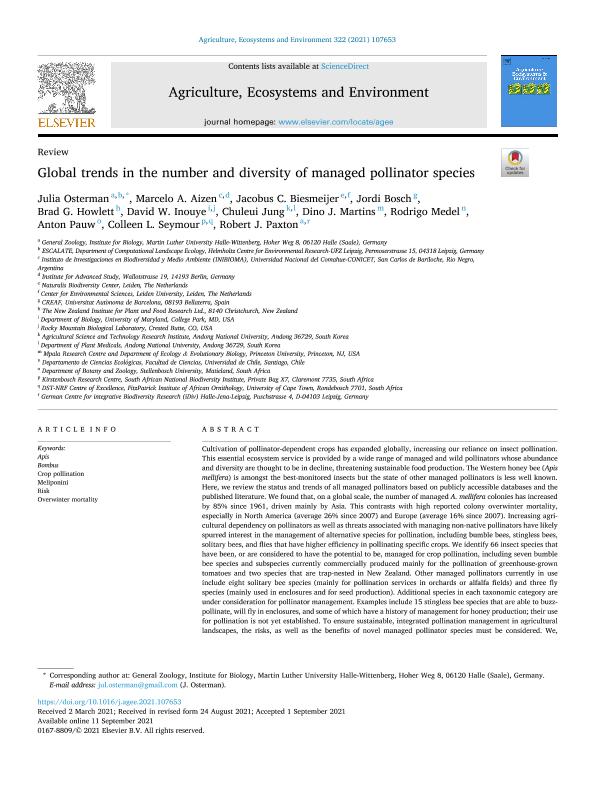Mostrar el registro sencillo del ítem
dc.contributor.author
Osterman, Julia
dc.contributor.author
Aizen, Marcelo Adrian

dc.contributor.author
Biesmeijer, Jacobus C.

dc.contributor.author
Bosch, Jordi
dc.contributor.author
Howlett, Brad G.
dc.contributor.author
Inouye, David W.

dc.contributor.author
Jung, Chuleui

dc.contributor.author
Martins, Dino J.
dc.contributor.author
Medel, Rodrigo
dc.contributor.author
Pauw, Anton
dc.contributor.author
Seymour, Colleen L.

dc.contributor.author
Paxton, Robert J

dc.date.available
2023-01-05T16:09:00Z
dc.date.issued
2021-12
dc.identifier.citation
Osterman, Julia; Aizen, Marcelo Adrian; Biesmeijer, Jacobus C.; Bosch, Jordi; Howlett, Brad G.; et al.; Global trends in the number and diversity of managed pollinator species; Elsevier Science; Agriculture, Ecosystems and Environment; 322; 107653; 12-2021; 1-13
dc.identifier.issn
0167-8809
dc.identifier.uri
http://hdl.handle.net/11336/183559
dc.description.abstract
Cultivation of pollinator-dependent crops has expanded globally, increasing our reliance on insect pollination. This essential ecosystem service is provided by a wide range of managed and wild pollinators whose abundance and diversity are thought to be in decline, threatening sustainable food production. The Western honey bee (Apis mellifera) is amongst the best-monitored insects but the state of other managed pollinators is less well known. Here, we review the status and trends of all managed pollinators based on publicly accessible databases and the published literature. We found that, on a global scale, the number of managed A. mellifera colonies has increased by 85% since 1961, driven mainly by Asia. This contrasts with high reported colony overwinter mortality, especially in North America (average 26% since 2007) and Europe (average 16% since 2007). Increasing agricultural dependency on pollinators as well as threats associated with managing non-native pollinators have likely spurred interest in the management of alternative species for pollination, including bumble bees, stingless bees, solitary bees, and flies that have higher efficiency in pollinating specific crops. We identify 66 insect species that have been, or are considered to have the potential to be, managed for crop pollination, including seven bumble bee species and subspecies currently commercially produced mainly for the pollination of greenhouse-grown tomatoes and two species that are trap-nested in New Zealand. Other managed pollinators currently in use include eight solitary bee species (mainly for pollination services in orchards or alfalfa fields) and three fly species (mainly used in enclosures and for seed production). Additional species in each taxonomic category are under consideration for pollinator management. Examples include 15 stingless bee species that are able to buzz-pollinate, will fly in enclosures, and some of which have a history of management for honey production; their use for pollination is not yet established. To ensure sustainable, integrated pollination management in agricultural landscapes, the risks, as well as the benefits of novel managed pollinator species must be considered. We, therefore, urge the prioritization of biodiversity-friendly measures maintaining native pollinator species diversity to provide ecosystem resilience to future environmental changes.
dc.format
application/pdf
dc.language.iso
eng
dc.publisher
Elsevier Science

dc.rights
info:eu-repo/semantics/openAccess
dc.rights.uri
https://creativecommons.org/licenses/by/2.5/ar/
dc.subject
APIS
dc.subject
BOMBUS
dc.subject
CROP POLLINATION
dc.subject
MELIPONINI
dc.subject
OVERWINTER MORTALITY
dc.subject
RISK
dc.subject.classification
Conservación de la Biodiversidad

dc.subject.classification
Ciencias Biológicas

dc.subject.classification
CIENCIAS NATURALES Y EXACTAS

dc.title
Global trends in the number and diversity of managed pollinator species
dc.type
info:eu-repo/semantics/article
dc.type
info:ar-repo/semantics/artículo
dc.type
info:eu-repo/semantics/publishedVersion
dc.date.updated
2022-10-06T13:10:11Z
dc.journal.volume
322
dc.journal.number
107653
dc.journal.pagination
1-13
dc.journal.pais
Países Bajos

dc.journal.ciudad
Amsterdam
dc.description.fil
Fil: Osterman, Julia. Martin Luther University Halle-Wittenberg; Alemania. Helmholtz Centre for Environmental Research; Alemania
dc.description.fil
Fil: Aizen, Marcelo Adrian. Consejo Nacional de Investigaciones Científicas y Técnicas. Centro Científico Tecnológico Conicet - Patagonia Norte. Instituto de Investigaciones en Biodiversidad y Medioambiente. Universidad Nacional del Comahue. Centro Regional Universidad Bariloche. Instituto de Investigaciones en Biodiversidad y Medioambiente; Argentina. Institute for Advanced Study; Alemania
dc.description.fil
Fil: Biesmeijer, Jacobus C.. Leiden University; Países Bajos. Naturalis Biodiversity Center; Países Bajos
dc.description.fil
Fil: Bosch, Jordi. Universitat Autònoma de Barcelona; España
dc.description.fil
Fil: Howlett, Brad G.. The New Zealand Institute for Plant and Food Research Ltd.; Nueva Zelanda
dc.description.fil
Fil: Inouye, David W.. University of Maryland; Estados Unidos. Rocky Mountain Biological Laboratory; Estados Unidos
dc.description.fil
Fil: Jung, Chuleui. Andong National University; Corea del Sur
dc.description.fil
Fil: Martins, Dino J.. University of Princeton; Estados Unidos
dc.description.fil
Fil: Medel, Rodrigo. Universidad de Chile; Chile
dc.description.fil
Fil: Pauw, Anton. Stellenbosch University; Sudáfrica
dc.description.fil
Fil: Seymour, Colleen L.. University of Cape Town; Sudáfrica. South African National Biodiversity Institute; Sudáfrica
dc.description.fil
Fil: Paxton, Robert J. German Centre for integrative Biodiversity Research; Alemania. Martin Luther University Halle-Wittenberg; Alemania
dc.journal.title
Agriculture, Ecosystems and Environment

dc.relation.alternativeid
info:eu-repo/semantics/altIdentifier/doi/https://doi.org/10.1016/j.agee.2021.107653
dc.relation.alternativeid
info:eu-repo/semantics/altIdentifier/url/https://www.sciencedirect.com/science/article/pii/S0167880921003571
Archivos asociados
